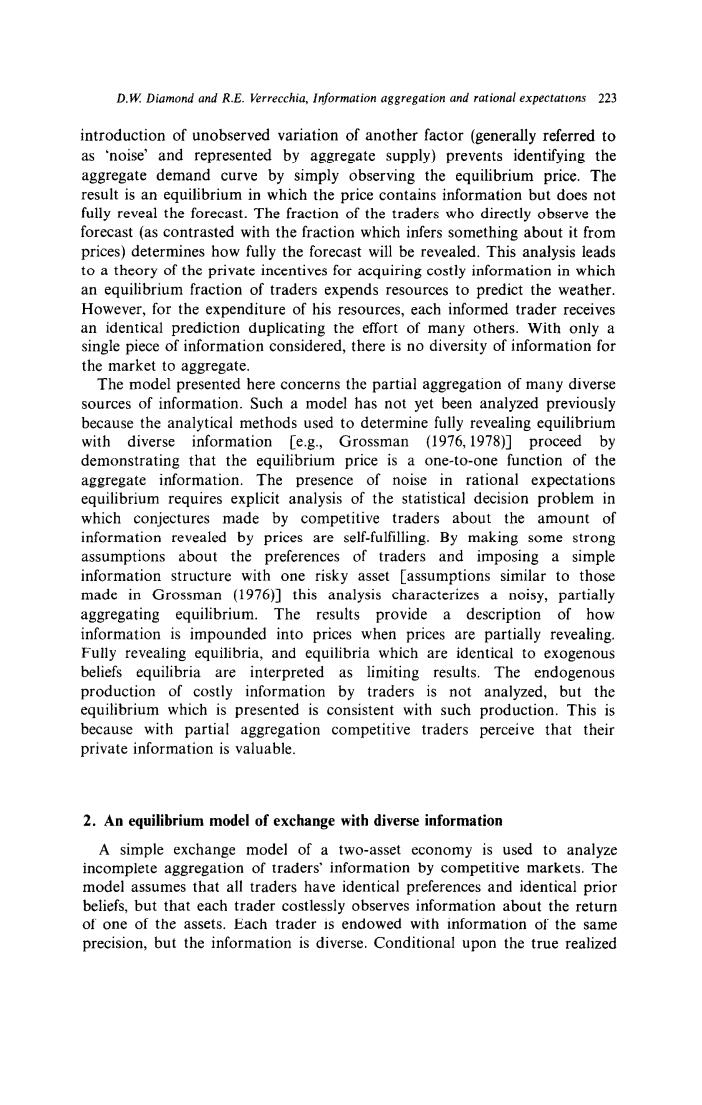正在加载图片...

D.W.Diamond and R.E.Verrecchia,Information aggregation and rational expectattons 223 introduction of unobserved variation of another factor (generally referred to as 'noise'and represented by aggregate supply)prevents identifying the aggregate demand curve by simply observing the equilibrium price.The result is an equilibrium in which the price contains information but does not fully reveal the forecast.The fraction of the traders who directly observe the forecast(as contrasted with the fraction which infers something about it from prices)determines how fully the forecast will be revealed.This analysis leads to a theory of the private incentives for acquiring costly information in which an equilibrium fraction of traders expends resources to predict the weather. However,for the expenditure of his resources,each informed trader receives an identical prediction duplicating the effort of many others.With only a single piece of information considered,there is no diversity of information for the market to aggregate. The model presented here concerns the partial aggregation of many diverse sources of information.Such a model has not yet been analyzed previously because the analytical methods used to determine fully revealing equilibrium with diverse information [e.g.,Grossman (1976,1978)]proceed by demonstrating that the equilibrium price is a one-to-one function of the aggregate information.The presence of noise in rational expectations equilibrium requires explicit analysis of the statistical decision problem in which conjectures made by competitive traders about the amount of information revealed by prices are self-fulfilling.By making some strong assumptions about the preferences of traders and imposing a simple information structure with one risky asset [assumptions similar to those made in Grossman (1976)]this analysis characterizes a noisy,partially aggregating equilibrium.The results provide a description of how information is impounded into prices when prices are partially revealing. Fully revealing equilibria,and equilibria which are identical to exogenous beliefs equilibria are interpreted as limiting results.The endogenous production of costly information by traders is not analyzed,but the equilibrium which is presented is consistent with such production.This is because with partial aggregation competitive traders perceive that their private information is valuable. 2.An equilibrium model of exchange with diverse information A simple exchange model of a two-asset economy is used to analyze incomplete aggregation of traders'information by competitive markets.The model assumes that all traders have identical preferences and identical prior beliefs,but that each trader costlessly observes information about the return of one of the assets.Each trader is endowed with information of the same precision,but the information is diverse.Conditional upon the true realizedD.W Diamond and R.E. Verrecchia, Information aggregation and rational expectations 223 introduction of unobserved variation of another factor (generally referred to as ‘noise’ and represented by aggregate supply) prevents identifying the aggregate demand curve by simply observing the equilibrium price. The result is an equilibrium in which the price contains information but does not fully reveal the forecast. The fraction of the traders who directly observe the forecast (as contrasted with the fraction which infers something about it from prices) determines how fully the forecast will be revealed. This analysis leads to a theory of the private incentives for acquiring costly information in which an equilibrium fraction of traders expends resources to predict the weather. However, for the expenditure of his resources, each informed trader receives an identical prediction duplicating the effort of many others. With only a single piece of information considered, there is no diversity of information for the market to aggregate. The model presented here concerns the partial aggregation of many diverse sources of information. Such a model has not yet been analyzed previously because the analytical methods used to determine fully revealing equilibrium with diverse information [e.g., Grossman (1976,1978)] proceed by demonstrating that the equilibrium price is a one-to-one function of the aggregate information. The presence of noise in rational expectations equilibrium requires explicit analysis of the statistical decision problem in which conjectures made by competitive traders about the amount of information revealed by prices are self-fulfilling. By making some strong assumptions about the preferences of traders and imposing a simple information structure with one risky asset [assumptions similar to those made in Grossman (1976)] this analysis characterizes a noisy, partially aggregating equilibrium. The results provide a description of how information is impounded into prices when prices are partially revealing. Fully revealing equilibria, and equilibria which are identical to exogenous beliefs equilibria are interpreted as limiting results. The endogenous production of costly information by traders is not analyzed, but the equilibrium which is presented is consistent with such production. This is because with partial aggregation competitive traders perceive that their private information is valuable. 2. An equilibrium model of exchange with diverse information A simple exchange model of a two-asset economy is used to analyze incomplete aggregation of traders’ information by competitive markets. The model assumes that all traders have identical preferences and identical prior beliefs, but that each trader costlessly observes information about the return of one of the assets. Each trader is endowed with information of the same precision, but the information is diverse. Conditional upon the true realized